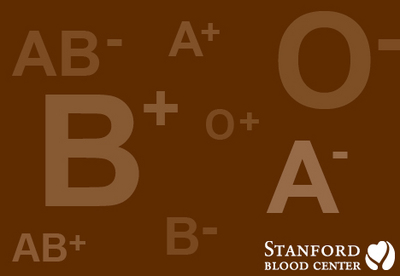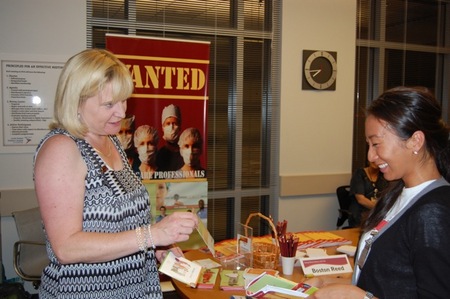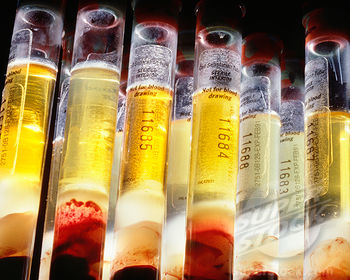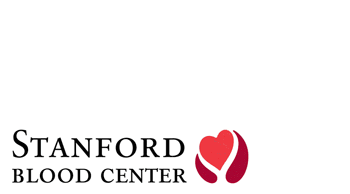 October 4, 2011 9:13 am
Published by Stanford Blood Center
October 4, 2011 9:13 am
Published by Stanford Blood Center
I looked at the date of my last plasma/platelet donation: March 7, 2011. It was August now I realized and as I blinked at the date, it seemed impossible to remember what life was like just those few short months ago there seemed to be such a gaping hole in reality and time. Within weeks of that donation in March, my Mom and I, together with the love of her life Alec, would celebrate her 60th birthday in the Cardiac Intensive Care Unit waiting for her operation to repair a heart valve and to replace 2 artificial ones.
September 30, 2011 8:00 am
Published by Stanford Blood Center

By Billie Rubin, Hemoglobin's Catabolic Cousin, reporting from the labs of Stanford Blood Center
You may have heard of geometric shapes that are infinitely complex like clouds or snowflakes, but there's also our complicated little ABO (blood group) system.
September 30, 2011 8:00 am
Published by Stanford Blood Center
By Julie Ruel, Social Media Manager, Stanford Blood Center
About every two seconds somebody in the U.S. needs blood. An estimated 38% of the population is eligible to give blood at any given time but less than 10% actually do. So blood centers must work hard to keep a constant supply on their shelves and ready to go. And as you know, we all rely on the support of generous volunteer donors. At Stanford Blood Center (SBC) specifically, we provide blood only to local hospitals and depend on the busy Bay Area folks (of which just 3% are active blood donors) to keep our inventory healthy.
 September 23, 2011 9:59 am
Published by Stanford Blood Center
September 23, 2011 9:59 am
Published by Stanford Blood Center
Mike Wu was diagnosed with Chronic Myelogenous Leukemia (CML) in January, 2003, after complain- ing to his doctor about persistent abdominal pain. It was one week before his wed- ding. He began taking a laundry list of prescribed medications that compromised his immune system; he lost about 30 pounds. He and his fiance, Jennifer, postponed the wedding so Mike could get better.
 September 20, 2011 9:42 am
Published by Stanford Blood Center
September 20, 2011 9:42 am
Published by Stanford Blood Center
My name is Gary Davis and I would like to share my experiences donating blood with my daughter Katie.
September 16, 2011 8:00 am
Published by Stanford Blood Center
By Lia Steakley, Social Media Producer, Stanford University School of Medicine

Woolly mammoths, which initially evolved in warm climates where African and Asian elephants now live, migrated to the cold regions of Eurasia in the Pleistocene glacial period. To survive living in the harsh permafrost, the Ice Age icons underwent distinct evolutionary changes such as growing long fur.
September 14, 2011 4:15 pm
Published by Stanford Blood Center
By Amanda Baker, Communications Intern, Stanford Blood Center

On Tuesday, Stanford Blood Center (SBC) hosted an encore of the Giving Blood Works promotion at our Hillview Center. This event brought together donors, recruiters, and career counselors for an evening including a networking techniques seminar, a chance to meet with recruiters from local companies, and an opportunity to sign up for half-hour resume critiques with career experts Lisa Stotlar and Ellen Shulman from CareerGenerations.
 September 9, 2011 11:40 am
Published by Stanford Blood Center
September 9, 2011 11:40 am
Published by Stanford Blood Center
Daniel Paepcke first started giving blood in January, 2003. Eight and a half years and 199 donations later, Daniel paid his regular visit to the Campus Center and made his 200th donation. Quite an accomplishment for the young man who at age 27, is one of our youngest donors to reach this milestone.
September 8, 2011 2:11 pm
Published by Stanford Blood Center
By Billie Rubin, Hemoglobin's Catabolic Cousin, reporting from the labs of Stanford Blood Center

Many of us are familiar with the role of red blood cells (RBCs) in taking oxygen throughout the body via the hemoglobin molecules they have inside, and of our platelets' ability to help prevent bleeding through creating clots. But white blood cells (WBCs), our immune system warriors, are a little more mysterious. They make up a complicated system of T-killer cells, T helper cells, antigen-presenting cells, antibody-producing cells, plus others. When a unit of un-coagulated whole blood is spun down to separate components, the white blood cells appear, creating a thin, white layer between the plasma and RBCs.
 September 1, 2011 4:13 pm
Published by Stanford Blood Center
September 1, 2011 4:13 pm
Published by Stanford Blood Center
Pulmonary hypertension, overriding aorta, and pulmonary atresia are a few of the health obstacles in little Maddie's life. She has undergone 11 procedures, including three open-heart surgeries, to correct her cardiovascular defects and has received the lifesaving gift of blood with each of her surgeries.





